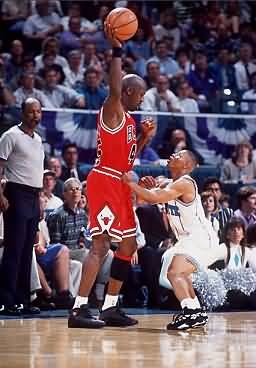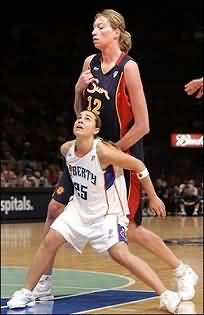"Smaller" Basketball Players: Perhaps the Best Athletes of All
by Thomas Emma
From the Coach’s Clipboard Basketball Playbook"Helping coaches coach better..."
Tom Emma was a graduate of Duke University, where he was a three-year basketball starter and captain his senior year, and was later drafted by the Chicago Bulls in 1983. He held a Masters degree from Columbia University, specialized in sports conditioning, was the owner of Power Performance, Inc. and published several books. Tom authored several other articles on this website. Sadly (after the original posting of this article), Tom died on June 8, 2011... Coach Gels.
Recently while watching a program on Public Television relating to why individuals grow to extreme heights, a certain fact caught my interest and attention. According to the show only 3 percent of American men reach the height of 6'5" or taller. Since I'm around tall people daily (one aspect of my job is training basketball players in strength, conditioning and skill development) I had a hard time believing this.
But after a little research of my own, I found the statement to be true. Not only that but the majority of countries around the world had an even lower percentage of 6'5" and overs than did the USA.
The above reality got me thinking about how utterly extraordinary "smaller", say 6'2" and under, players have to be to make an NBA team or even crack a Division 1 NCAA basketball roster. According to NBA.com the combined rosters of Atlantic Division teams, which includes the Boston Celtics, New Jersey Nets, New York Knicks, Philadelphia 76ers, and Toronto Raptors, featured 43 players listed at 6'7" or better and only 9 players listed at 6'2" and under.
This comes out to a little more than an 8 to 2 ratio bigger to smaller. Obviously, the NBA, with an average height of about 6'7", is a tall man's league.
And what is perhaps most impressive about these diminutive (by basketball standards) athletes is the fact that smaller players are competing for those few openings against a much larger talent pool (remember the 6"5" and over stat). To illustrate the point further, let me ask two questions.

Question #1: Provided you're not in an occupation that requires you to be in the presence tall individuals, how many 6'7" or taller men have you seen in your daily life over the past month?
Question #2: How many 6'2" and under men have you come across in that same time period? You see where I'm going with this. The answer to question #1 is likely zero or at most somewhere in the very low single digits. While the answer to question #2 could be in the hundreds or more depending upon where you live and what you do during the course of a normal day.
Adding to the magnificence of smaller basketball players is the fact that bigger, taller athletes have many distinct advantages relating to the game itself. Most obvious is that they are closer to the 10-foot high basket, making it easier for them to shoot a high percentage from close range (most of the highest percentage field goal shooters in both college and professional basketball are traditionally centers or taller forwards).
Taller players also have first crack at rebounds that carom off the rim, an advantage when blocking or disrupting shots, and the luxury of shooting and passing over shorter defenders on a regular basis.
Additionally (and often overlooked) bigger athletes generally expend less energy than their smaller counterparts when performing similar on-court tasks. For example, when 6'2", 185 lbs. San Antonio Spurs all-star guard Tony Parker drives the lane and shoots one of his patented reverse lay-ups or floaters the physical demands (i.e., negotiating to the position on the court, absorbing contact from substantially larger players, hitting the floor regularly, and jumping and landing higher and harder during the shooting process) are much greater than when his 7'0" superstar teammate Tim Duncan executes a short jump hook, power lay-up/dunk, or tip in.
This added energy expenditure is, in my opinion, one of the major reasons why guards rarely play effectively, if at all, past 35 years of age or so. The wear and tear takes its toll. (The one exception is 6'2" Utah Jazz Hall-of-Famer, John Stockton, who continued to perform at a consistently high level until he retired at age 40.)
The above underscores how skilled, athletic, and durable smaller, high level players must be just to compete in the big man's game of basketball. Players such as Chris Paul, Steve Nash, and the aforementioned Tony Parker are extreme anomalies who not only possess tremendous physical gifts but were required, because of their relative lack of size, to put in countless hours honing their games and bodies as youngsters.

Of course, most, if not all, smaller basketball players already know this. They realize that in order to survive and thrive on the hardwood they must work diligently day in and day out on improving and perfecting their skills. They understand that there is no such thing as a 6'0" project in basketball (unless said six-footer is in 6th grade)!
Project status is reserved for up and coming centers and power forwards who someday (hopefully) will grow into their bodies and become impact athletes. As such, in order for guards to draw attention from scouts, coaches, and general managers they must come to the table (court) as near finished products with a skill set that allows them to contribute immediately.
Those who make the decisions in the basketball world traditionally have very little patience with the development of smaller players, feeling rightly or wrongly that they can be easily found and/or replaced.
Before signing off, I don't want readers to think that I am in any way disparaging bigger, taller basketball players. They are all impressive in their own right. Many combine their great size with extraordinary speed, agility, coordination, and athleticism that boggles the mind.
Any player big, medium, or small who develops their game enough to play the great, extremely competitive sport of basketball at a high level deserves the utmost respect and credit.